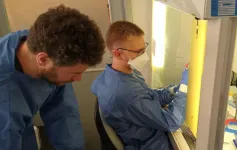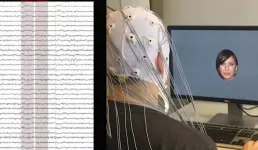Retinal implants can give artificial vision to the blind
2021-03-05
(Press-News.org) Being able to make blind people see again sounds like the stuff of miracles or even science fiction. And it has always been one of the biggest challenges for scientists. Diego Ghezzi, who holds the Medtronic Chair in Neuroengineering (LNE) at EPFL's School of Engineering, has made this issue a research focus. Since 2015, he and his team have been developing a retinal implant that works with camera-equipped smart glasses and a microcomputer. "Our system is designed to give blind people a form of artificial vision by using electrodes to stimulate their retinal cells," says Ghezzi.
Read more: https://actu.epfl.ch/news/a-retinal-implant-that-is-more-effective-against-b/
Star-spangled sky
The camera embedded in the smart glasses captures images in the wearer's field of vision, and sends the data to a microcomputer placed in one of the eyeglasses' end-pieces. The microcomputer turns the data into light signals which are transmitted to electrodes in the retinal implant. The electrodes then stimulate the retina in such a way that the wearer sees a simplified, black-and-white version of the image. This simplified version is made up of dots of light that appear when the retinal cells are stimulated. However, wearers must learn to interpret the many dots of light in order to make out shapes and objects. "It's like when you look at stars in the night sky - you can learn to recognize specific constellations. Blind patients would see something similar with our system," says Ghezzi.
Running simulations, for now
The only catch is that the system has not yet been tested on humans. The research team first needs to be certain of their results. "We aren't yet authorized to implant our device in human patients, since obtaining the medical approval takes a long time. But we came up with a process for testing it virtually - a type of work-around," says Ghezzi. More specifically, the engineers developed a virtual reality program that can simulate what patients would see with the implants. Their findings have just been published in Communication Materials.
Field of vision and resolution
Two parameters are used to measure vision: field of vision and resolution. The engineers therefore used these same two parameters to evaluate their system. The retinal implants they developed contain 10,500 electrodes, with each one serving to generate a dot of light. "We weren't sure if this would be too many electrodes or not enough. We had to find just the right number so that the reproduced image doesn't become too hard to make out. The dots have to be far enough apart that patients can distinguish two of them close to each other, but there has to be enough of them to provide sufficient image resolution," says Ghezzi.
The engineers also had to make sure that each electrode could reliably produce a dot of light. Ghezzi explains: "We wanted to make sure that two electrodes don't stimulate the same part of the retina. So we carried out electrophysiological tests that involved recording the activity of retinal ganglion cells. And the results confirmed that each electrode does indeed activate a different part of the retina."
The next step was to check whether 10,500 light dots provide good enough resolution - and that's where the virtual reality program came in. "Our simulations showed that the chosen number of dots, and therefore of electrodes, works well. Using any more wouldn't deliver any real benefits to patients in terms of definition," says Ghezzi.
The engineers also performed tests at constant resolution but different field-of-vision angles. "We started at five degrees and opened up the field all the way to 45 degrees. We found that the saturation point is 35 degrees - the object remains stable beyond that point," says Ghezzi. All these experiments demonstrated that the system's capacity doesn't need to be improved any further, and that it's ready for clinical trials. But the team will have to wait a little longer before their technology can be implanted in actual patients. For now, restoring vision remains in the realm of science fiction.
INFORMATION:
[Attachments] See images for this press release:

ELSE PRESS RELEASES FROM THIS DATE:
2021-03-05
In order to stay alive, the cell must provide its various organelles with all the energy elements they need, which are formed in the Golgi apparatus, its centre of maturation and redistribution of lipids and proteins. But how do the proteins that carry these cargoes - the kinesins - find their way and direction within the cell's "road network" to deliver them at the right place? Chemists and biochemists at the University of Geneva (UNIGE), Switzerland, have discovered a fluorescent chemical dye, making it possible for the first time to track the transport ...
2021-03-05
More Antarctic meltwater is surfacing than was previously known, modifying the climate, preventing sea ice from forming and boosting marine productivity- according to new research from the University of East Anglia (UEA).
For the first time, researchers have been able to obtain full-depth glacial meltwater observations in winter, using instruments attached to the heads of seals living near the Pine Island Glacier, in the remote Amundsen Sea in the west of Antarctica.
The harsh environmental conditions in the Antarctic limit the use of most traditional observation systems, such as ships and airplanes, especially ...
2021-03-05
Researchers at Scripps Institution of Oceanography at UC San Diego examining 14 years of hospital admissions data conclude that the fine particles in wildfire smoke can be several times more harmful to human respiratory health than particulate matter from other sources such as car exhaust. While this distinction has been previously identified in laboratory experiments, the new study confirms it at the population level.
This new research work, focused on Southern California, reveals the risks of tiny airborne particles with diameters of up to 2.5 microns, about one-twentieth that of a human hair. These particles - termed PM2.5 - are the ...
2021-03-05
Satellite imagery shows that the area covered by kelp forests off the coast of Northern California has dropped by more than 95 percent, with just a few small, isolated patches of bull kelp remaining. Species-rich kelp forests have been replaced by "urchin barrens," where purple sea urchins cover a seafloor devoid of kelp and other algae.
A new study led by researchers at UC Santa Cruz documents this dramatic shift in the coastal ecosystem and analyzes the events that caused it. This was not a gradual decline, but an abrupt collapse of the kelp forest ecosystem in the aftermath of unusual ocean warming along the West Coast starting in 2014, part of a series of events that combined to decimate the kelp forests.
Published March 5 in Communications Biology, ...
2021-03-05
Quantitative real-time polymerase chain reaction (qPCR) is the most widely used diagnostic method to detect RNA viruses such as SARS-CoV-2. However, it requires expensive laboratory equipment and global shortages of reagents for RNA purification has increased the need to find simple but reliable alternatives. One alternative to the qPCR technology is RT-LAMP (reverse transcription loop-mediated isothermal amplification). This test amplifies the desired target sequences of the virus at a constant temperature, using minimal equipment compared to qPCR. In 2020, it was adapted to the detection of SARS-CoV-2. It was also shown that instead of a swab, which many people find unpleasant, it can be performed on gargle lavage samples.
First author Lukas Bokelmann and colleagues have now ...
2021-03-05
Researchers from the Pan African Programme: The Cultured Chimpanzee (PanAf) at the Max Planck Institute for Evolutionary Anthropology (MPI-EVA) and a team of international researchers, collected over 5000 fecal samples from 55 sites in 18 countries across the chimpanzee range over 8 years. This is by far the most complete sampling of the species to date, with a known location of origin for every sample, thus addressing the sampling limitations of previous studies. "Collecting these samples was often a daunting task for our amazing field teams. The chimpanzees were almost all unhabituated to human presence, so it took a lot of patience, skill and luck to find chimpanzee dung at each of the sites," explains ...
2021-03-05
Researchers have developed a new quantum version of a 150-year-old thermodynamical thought experiment that could pave the way for the development of quantum heat engines.
Mathematicians from the University of Nottingham have applied new quantum theory to the Gibbs paradox and demonstrated a fundamental difference in the roles of information and control between classical and quantum thermodynamics. Their research has been published today in Nature Communications.
The classical Gibbs paradox led to crucial insights for the development of early thermodynamics and emphasises the need to consider an experimenter's ...
2021-03-05
DUBLIN, Friday, 5 March 2021: RCSI researchers have discovered a new way to 'put the brakes' on excessive inflammation by regulating a type of white blood cell that is critical for our immune system.
The discovery has the potential to protect the body from unchecked damage caused by inflammatory diseases.
The paper, led by researchers at RCSI University of Medicine and Health Sciences, is published in Nature Communications.
When immune cells (white blood cells) in our body called macrophages are exposed to potent infectious agents, powerful inflammatory proteins ...
2021-03-05
New York, NY (March 5, 2021) - Overweight children who were exposed to lead in utero and during their first weeks of life have the potential for poorer kidney function in adulthood, according to an Icahn School of Medicine at Mount Sinai study published in Environment International in March.
The study found that children with high body mass indexes who had been exposed to lead had lower estimated glomerular filtration rate (eGFR), a measure of how well the kidneys are filtering or cleaning the blood. The researchers measured blood levels during mothers' pregnancy and later measured eGFR levels in the children when they were between 8 and 12 years old.
Decreased ...
2021-03-05
Researchers have succeeded in making an AI understand our subjective notions of what makes faces attractive. The device demonstrated this knowledge by its ability to create new portraits on its own that were tailored to be found personally attractive to individuals. The results can be utilised, for example, in modelling preferences and decision-making as well as potentially identifying unconscious attitudes.
Researchers at the University of Helsinki and University of Copenhagen investigated whether a computer would be able to identify the facial features we consider attractive and, based on this, create new images matching our criteria. The researchers used artificial intelligence to interpret brain signals and combined the resulting brain-computer interface with a ...
LAST 30 PRESS RELEASES:
[Press-News.org] Retinal implants can give artificial vision to the blind






